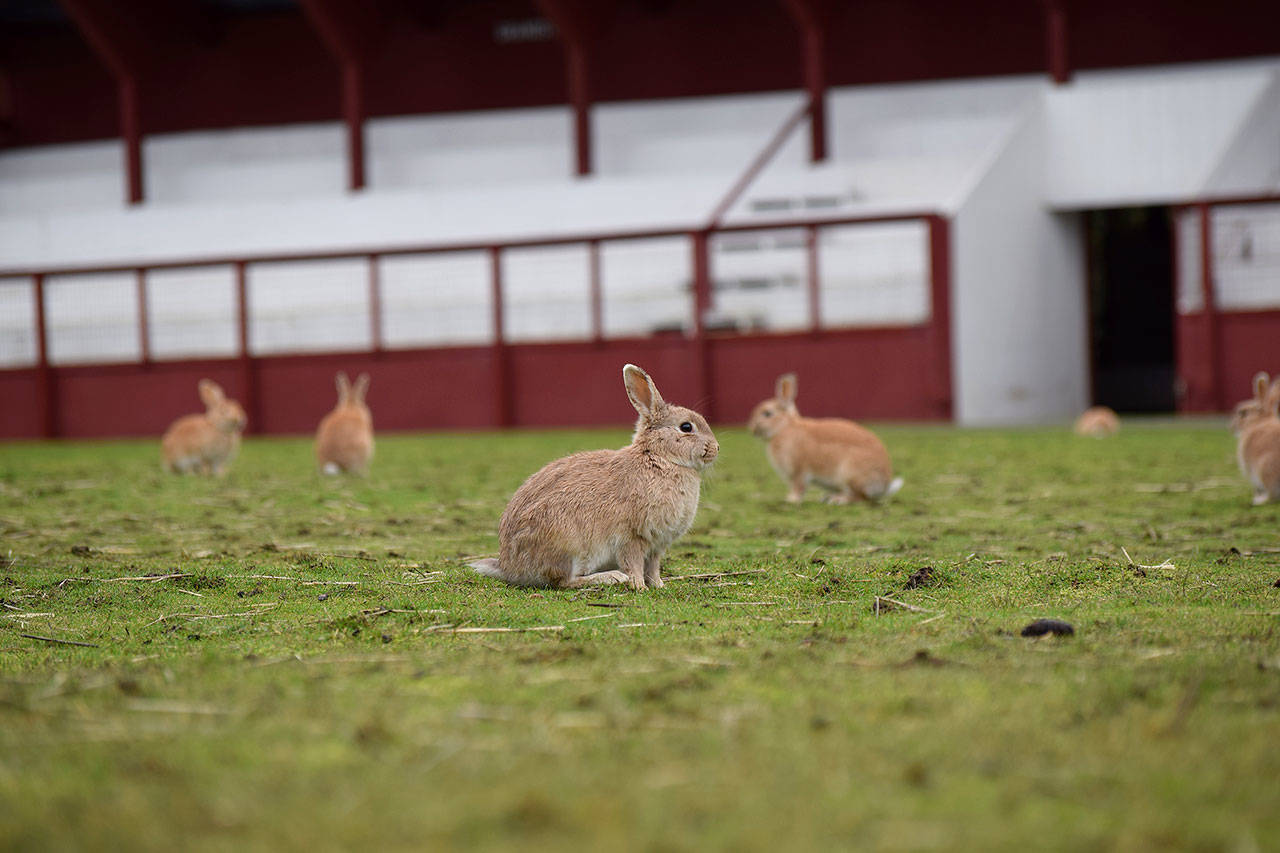Concerns over diseases and rabbit hole liability has brought back Langley’s bunny discussion.
The Fairgrounds Advisory Committee, the group overseeing the property’s transfer to the Port of South Whidbey, discussed what to do about the city’s large rabbit population at last month’s meeting.
The committee is eyeing solutions to potential problems the bunnies present just at the fairgrounds, rather than the City of Langley. The conversation is in its early days, and committee members know there could be a long road ahead.
It was an issue that divided opinion in 2015 and even gained national news coverage.
“It was brought up at the committee meeting because we were looking at the liability the rabbits bring, and the rabbit holes came up,” Gary Gabelein, who heads the committee, said. “I think it’s a topic that’s gonna be covered a lot more.”
The advisory committee, made up of stakeholders from fairgrounds user groups, is concerned about a range of issues the rabbits present. Representatives from user groups that deal with animals, including Island County 4-H, are worried about the rabbits’ potential to spread diseases and parasites to other animals at the fair. Port of South Whidbey Executive Director Angi Mozer admitted port maintenance staff members have twisted and sprained ankles from the bunny burrows on the fairgrounds, leaving the port district at risk of being sued. Property damage is also a concern, as it has been since the problem began. The rabbits chew through vegetation and dig holes to warren.
Langley is populated by two rabbit species, South Whidbey veterinarian Dave Parent says. The European rabbit, or the Langley rabbit as Parent also refers to them, create the burrow. The eastern cottontail, the other species, do not.
Animal health is fresh on 4-H committee representative Cathi Mann-Fisher’s mind. Reports of equine herpesvirus type-1 (EHV-1) killing seven horses in King County late last year have horse groups up in arms about equine health in general. However, Parent says there isn’t evidence rabbits can spread EHV-1, which is transmitted horse-to-horse. Rabbits can spread other diseases and parasites, though it’s not that common, he said.
“I heard about the outbreak, but how rabbits can transmit that, I’m not sure,” Parent said. “They don’t really do that. There’s not that much of a human or animal health risk. They mainly cause property damage. There is tularemia that can spread to humans, but it’s not that likely.”
According to the Centers for Disease Control and Prevention, tularemia can be life-threatening but can be treated successfully with antibiotics. It causes fevers, skin ulcers and exhaustion.
When the City of Langley discussed if and how it should lower the rabbit population in 2015 — when some city residents complained about property damage and the South Whidbey School District complained of student athlete injuries from rabbit holes — some ideas to cull the bunny population created firm opposition. An online petition was created in opposition to the idea of introducing birds of prey via Clinton falconer Steve Layman, the cheapest option discussed. The raptor idea even warranted opposition from international animal rights group People for the Ethical Treatment of Animals (PETA), which described the idea as “exceedingly inhumane.” A group representative explained it wasn’t natural to unleash birds of prey on a domesticated rabbit lacking wild instincts.
PETA urged officials to trap and transfer the bunnies to shelters, instead.
However, the falcon idea is being floated once again by the Fairgrounds Advisory Committee. This time, it would be for the island’s natural resident birds of prey, not Layman’s own.
“The only suggestion we’ve heard so far that we’d feel comfortable pursuing is potentially installing a perch at the fairgrounds for natural wildlife,” Mozer said. “Not a nesting place, but a stopping place. We definitely wouldn’t pursue a more aggressive approach at this time.”
Currently, fairgrounds maintenance crews fill burrows they find. Mozer admits it hasn’t been successful, as the rabbits “love to dig the holes back out immediately.” Crews have tried filling the holes with “something less fun for the rabbits to dig back out,” such as gravel, but that damages lawn mowers and brings a new safety hazard with flying rocks.
All other solutions are cost prohibitive, Mozer admits.
Gabelein said the committee could also go with additional signage indicating the fair isn’t liable for diseases fair animals could contract. However, he admits the talks are in the early stages and will continue. Gabelein did express his surprise that falcons haven’t already moved in to the fairgrounds area.
“I had a rabbit problem at my bed and breakfast, and what happened is we had three to five bald eagles move in,” Gabelein said. “Over a five-year period, we just ran out of rabbits. I can’t believe a predator hasn’t gone to Langley near the fairgrounds to find a smorgasbord for dinner.”



